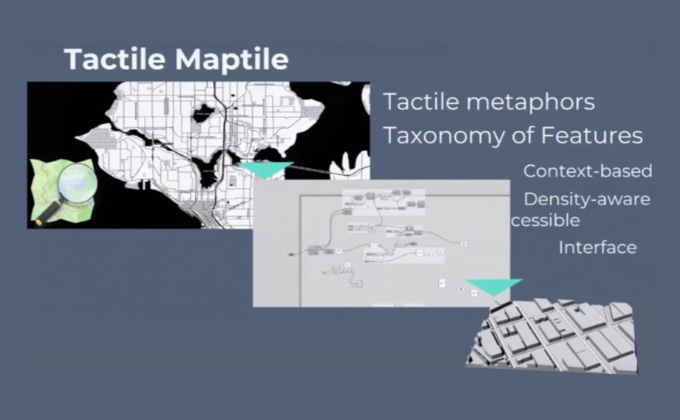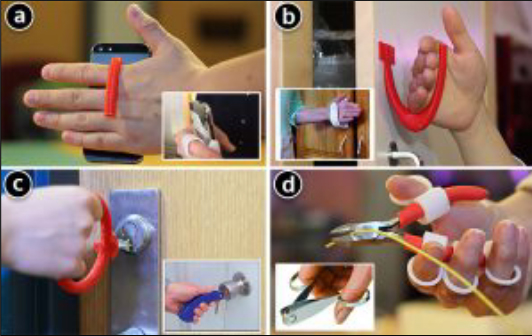Physical computing, the combination of consumer-grade fabrication and computing technology, enables participation for people with disabilities in multiple home and community contexts.
Rooted in an interdisciplinary approach blending disciplines of engineering, computer science, rehabilitation technology, and the maker movement, physical computing can be used to enhance community living and participation by producing solutions for use in daily life. Customized objects can meet individual needs and can be designed to fit and interact with a wide range of bodies. Access to these technologies and the services and training that support their use within the community is increasingly recognized as a fundamental human right.
Physical computing technology, now widely available, includes 3D-modeling software and machines such as laser cutters, 3D-printers, knitting machines and programmable embroidery machines. The costs of both the machines and the software needed to create things with them have come down sufficiently that they are becoming more and more common in small scale and even do-it-yourself (DIY) settings such as makerspaces, libraries, clinics, and schools. Similarly, embedded computing boards such as the Arduino and Raspberry Pi are becoming prevalent and accessible even for beginning makers.
Recent and impactful work
These technologies are already making a demonstrable and significant impact on community living and participation for people with disabilities. Recent examples demonstrate the wide range of ways that community living can be influenced by fabricated solutions.

3D-printed tactile maptiles for visually impaired persons: CREATE members have created 3D-printed tactile maptiles that can convey complex spatial information to support travel and navigation outside the home.
Custom tactile interactions on devices: Similarly, custom devices can also positively impact participation in sports and other physical activities or to make inaccessible interfaces, such as touch screens on phones, appliances, and other devices accessible with custom tactile interactions.


Specialized tools for creating assistive technology: The development of specialized tools for creating assistive technology, which can be iteratively designed and shared to produce custom grips, levers, guides, and other devices for daily life.
Physical computing is revolutionizing the range of accessibility solutions available to people with disabilities to maximize community participation. To date, the development of specialized tools for creating assistive technology is the largest area where physical computing has intersected accessibility.
Early progress in medical making and DIY communities
Our studies show this work already taking place in two spaces–medical making and DIY communities, where it is a new thread in a long history of bespoke, community accessible technology production.
While physical computing offers powerful new tools for innovation it also raises challenging new issues, from safety to testing to sharing designs. These issues have been highlighted in interactions with our partners. For example, the Veterans Administration (VA) Puget Sound, Seattle Children’s Hospital, and Provail have all invested significant funds and resources in fabrication and physical computing technologies.
- The VA has invested over $2 million to acquire equipment that can support physical computing.
- Provail–a community organization that is dedicated to meeting the needs of children, youth, and adults with disabilities–now has 3D-printers and other fabrication tools in-house to help create bespoke solutions that can support community living and participation.
All of these partners have found it incredibly difficult, however, to find personnel with the required expertise in both rehabilitation and physical computing to bridge the gap from ideas to community.
Accelerating progress with training
CREATE’s recently funded NIDILRR ARRT on Physical Computing in Community Living and Participation is a training grant designed to train leaders in rehabilitation research who can harness advances in physical computing and fabrication to enhance community living and participation with people
with disabilities.
This program will train postdoctoral fellows to be leaders in physical computing for rehabilitation research that supports community living and participation. Each fellow will complete a 12 to 24-month training program that will build their expertise in physical computing, fabrication, and disability studies. Training will include research, coursework and mentoring that expand expertise in using basic and complex adaptation tools, 3D-modeling software, and fabrication machines (e.g., laser cutters, 3D-printers) for rehabilitation applications.
This program will bring together fellows from both rehabilitation and engineering backgrounds to work together along with our community partners and people with disabilities. Our proposed training program will help to fill the gap in available talent that combines deep knowledge of rehabilitation and disability studies with the skills needed to fully realize the potential of physical computing to support people with disabilities and their engagement in the daily life of their communities.
The first class of ARRT fellows started in Summer of 2022.
RELATED RESEARCH NEWS
Articles on physical computing research at CREATE.
Former CREATE postdoc Sasha Portnova talks about her experiences and inspirations
November 22, 2024 Dr. Alexandra (Sasha) Portnova, a postdoctoral researcher with CREATE in 2022-24, was interviewed about those experiences as a NIDILRR-funded fellow and about her work in rehabilitation research. In the National Rehabilitation Information Center interview, Portnova spoke about the value of the CREATE ARRT fellowship in transitioning from the overwhelming life as a…
Mobile 3D printer can autonomously add accessibility features to a room
October 29, 2024 From accessibility upgrades to a custom cat-food bowl, a prototype mobile 3D printer is being used to change the built environment and tailor spaces for peoples’ needs or style preferences. Built on a modified consumer vacuum robot, MobiPrint can automatically measure a room and print objects onto its floor to add accessibility…
- News about our new post docs
- News article about the ARRT grant
- Publications relevant to fabrication (blurbs and links?)